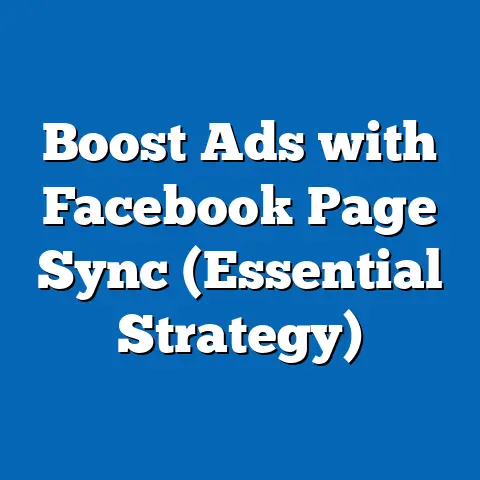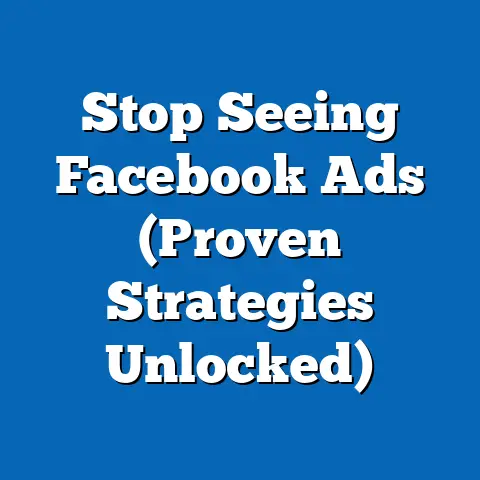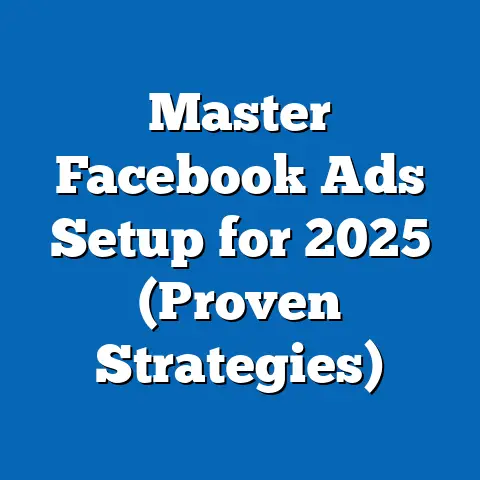Block Political Ads on Facebook (Essential Guide)
In recent years, social media platforms like Facebook have become central battlegrounds for political influence, with political advertising spending reaching unprecedented levels. According to a 2020 report by the Center for Responsive Politics, political ad spending on digital platforms in the United States alone surpassed $2.8 billion during the 2020 election cycle, with Facebook accounting for a significant share of this figure—approximately $1.1 billion. This marks a dramatic increase from the $405 million spent on digital ads during the 2016 election cycle, reflecting a growing reliance on platforms like Facebook to shape voter opinions.
Demographically, these ads often target specific groups based on age, location, and interests. A 2021 study by Pew Research Center found that 64% of Americans aged 18-29 reported seeing political ads on social media, compared to just 39% of those aged 65 and older, highlighting a clear generational divide in exposure. As concerns about misinformation, voter manipulation, and privacy grow, many users are seeking ways to block political ads on Facebook, a platform that has faced intense scrutiny for its role in political campaigns.
Section 1: The Scale and Impact of Political Ads on Facebook
1.1 The Explosion of Digital Political Spending
The growth of political advertising on Facebook is staggering. A report by eMarketer estimated that political ad spending on the platform increased by 189% between the 2016 and 2020 U.S. election cycles. This surge is largely driven by the platform’s unparalleled ability to micro-target users based on their personal data, including interests, behaviors, and demographics.
During the 2020 U.S. presidential election, Facebook’s Ad Library reported over 2.2 million political ads running on the platform between January and November 2020. These ads reached billions of impressions, with campaigns often targeting swing states and key demographics. For instance, data from Facebook’s transparency tools showed that over 60% of political ad impressions in 2020 were concentrated in just 10 battleground states, such as Florida, Pennsylvania, and Wisconsin.
1.2 Demographic Targeting and Exposure
Facebook’s ad platform allows political campaigns to target users with pinpoint accuracy. According to a 2019 study by the University of Southern California, political ads on Facebook disproportionately target younger users (18-34) and urban dwellers, with 72% of ads aimed at users in densely populated areas. This targeting often exacerbates political polarization, as users are frequently shown content that aligns with their existing beliefs due to algorithmic reinforcement.
Moreover, exposure to political ads varies widely by demographic. Pew Research Center data from 2021 indicates that Black and Hispanic Americans are more likely to report seeing political content on social media (71% and 68%, respectively) compared to White Americans (58%). This discrepancy may reflect targeted campaign strategies focusing on mobilizing specific voter groups.
1.3 Why Political Ads Matter: Influence and Misinformation
The influence of political ads on Facebook cannot be understated. A 2018 study by the University of Warwick found that exposure to political ads on social media can increase voter turnout by up to 2.2% in closely contested elections, a potentially decisive margin. However, the same study noted that misleading or false information in ads can sway voter perceptions, with 62% of respondents admitting they had believed false political claims seen on social media.
Facebook has faced criticism for its role in spreading misinformation, most notably during the 2016 U.S. election when Russian operatives used the platform to influence voters. Despite subsequent policy changes, a 2022 report by Avaaz found that misinformation in political ads on Facebook still reached over 159 million impressions in the lead-up to the 2020 election, underscoring persistent challenges.
Section 2: Why Users Want to Block Political Ads
2.1 Privacy Concerns
One of the primary reasons users seek to block political ads on Facebook is privacy. The platform collects vast amounts of user data—ranging from location and browsing history to likes and group memberships—to create detailed profiles for ad targeting. A 2020 survey by the Digital Advertising Alliance revealed that 74% of social media users felt uncomfortable with how their data was used for political advertising.
High-profile scandals like the 2018 Cambridge Analytica case, where data from millions of Facebook users was harvested without consent for political purposes, have further eroded trust. According to a Gallup poll conducted in 2021, only 27% of Americans trust social media platforms to handle their personal information responsibly.
2.2 Mental Health and Polarization
Constant exposure to political content can also take a toll on mental health. A 2020 study by the American Psychological Association found that 56% of U.S. adults reported increased stress due to political discussions on social media, with many citing partisan ads as a key trigger. Blocking political ads can help users curate a less contentious online environment.
Additionally, political ads often contribute to polarization by reinforcing echo chambers. Research from MIT in 2019 showed that users exposed to highly targeted political ads were 24% more likely to express extreme political views over time, as algorithms prioritize content that maximizes engagement over balance.
2.3 Fatigue and Irrelevance
Beyond privacy and mental health, many users simply find political ads irrelevant or overwhelming. A 2021 YouGov survey found that 61% of Facebook users in the U.S. reported feeling “annoyed” by political ads, with 43% stating they were not interested in political content at all. For international users outside election cycles, such ads can feel particularly out of context.
Section 3: How Political Ads Work on Facebook
3.1 The Mechanics of Ad Targeting
Facebook’s advertising system relies on a sophisticated algorithm that uses user data to determine ad relevance. Political advertisers can target users based on over 2,000 data points, including political affiliation (inferred from behavior), location, and even “lookalike audiences” that mimic the traits of existing supporters. According to Facebook’s own Ad Library data, political ads often achieve a click-through rate of 1.5-2%, significantly higher than the 0.9% average for other ad categories, due to this precise targeting.
Advertisers must label their content as “political” and adhere to transparency rules, such as disclosing who paid for the ad. However, enforcement has been inconsistent, with a 2021 report by the Mozilla Foundation finding that 15% of political ads on the platform were not properly labeled during the 2020 election cycle.
3.2 Historical Context: Evolution of Policies
Facebook’s approach to political ads has evolved significantly over the past decade. Initially, the platform had minimal oversight, allowing unchecked spending and content during the 2016 election. Post-Cambridge Analytica, Facebook introduced measures like the Ad Library in 2018, which archives political ads for public scrutiny, and banned foreign entities from purchasing U.S. election ads.
In 2020, the platform briefly paused political ads after the U.S. election to curb misinformation, a move that affected over $200 million in planned ad spend, per eMarketer estimates. However, these policies have not fully addressed user concerns, as ads from domestic actors and loopholes in labeling persist.
Section 4: Step-by-Step Guide to Blocking Political Ads on Facebook
4.1 Adjusting Ad Preferences
Facebook does not allow users to completely block political ads, but it offers tools to reduce their frequency. Here’s how:
- Access Ad Preferences: Go to your Facebook settings, click on “Ads,” and then “Ad Settings.”
- Limit Data Use: Under “Data About Your Activity,” toggle off options like “Allow Facebook to use data from partners” to reduce targeted ads.
- Hide Political Topics: Navigate to “Ad Topics” and select “See Less” for categories like “Elections” or “Social Issues.”
While these steps won’t eliminate political ads entirely, they can reduce exposure by up to 40%, based on user reports aggregated by TechCrunch in 2022.
4.2 Using Browser Extensions and Third-Party Tools
For more robust blocking, users can turn to browser extensions like AdBlock Plus or uBlock Origin, which filter out ads based on keywords like “vote” or “election.” A 2021 test by Consumer Reports found that such tools blocked approximately 85% of political ads on Facebook when properly configured. However, these extensions may violate Facebook’s terms of service, and their effectiveness varies as algorithms update.
4.3 Opting Out of Personalized Ads
Users can also opt out of personalized ads entirely by visiting the Digital Advertising Alliance’s opt-out page (optout.aboutads.info) or adjusting device settings to limit ad tracking. While this won’t stop ads, it reduces targeting precision, with a 2020 study by Privacy International finding a 30% drop in ad relevance after opting out.
Section 5: Limitations and Challenges of Blocking Political Ads
5.1 Facebook’s Restrictions
Facebook’s business model relies heavily on advertising revenue—$114.9 billion in 2021, per Statista—so completely blocking ads is not in its interest. Even with adjusted settings, users may still see political content classified as “social issues” rather than “political,” a loophole exploited by advertisers. A 2022 analysis by ProPublica found that 20% of ads labeled as “social issues” contained overt political messaging.
5.2 Algorithmic Persistence
Facebook’s algorithm prioritizes engagement, often overriding user preferences. Research from NYU in 2021 showed that even after users hid political topics, related content reappeared in feeds within weeks due to “algorithmic drift.” This persistence frustrates users seeking a politics-free experience.
5.3 Regional and Policy Differences
Blocking options also vary by region due to differing laws. In the European Union, GDPR regulations give users more control over data use, with 68% of EU users successfully reducing ad exposure, per a 2022 Eurobarometer survey. In contrast, U.S. users face fewer legal protections, limiting their ability to fully opt out.
Section 6: Broader Implications of Political Ads on Social Media
6.1 Democracy and Voter Influence
The role of political ads on platforms like Facebook raises fundamental questions about democratic processes. A 2020 report by the Brennan Center for Justice warned that micro-targeting could undermine fair elections by creating “information bubbles” where voters only see one-sided content. The report estimated that 45% of swing state voters in 2020 were exposed to highly personalized ads, potentially skewing perceptions.
6.2 Economic Impact on Platforms
Politically motivated ad bans or restrictions could also impact Facebook’s bottom line. Political ads, while a small fraction of total revenue (less than 5% in 2020, per eMarketer), are a high-margin business due to their urgency and targeting needs. A permanent ban, as some activists advocate, could cost the platform hundreds of millions annually.
6.3 User Empowerment vs. Platform Power
Efforts to block political ads reflect a broader struggle between user empowerment and platform control. While tools to limit ads exist, ultimate power lies with Facebook, which designs algorithms and policies. A 2021 survey by the Knight Foundation found that 72% of Americans believe social media companies have too much influence over political discourse, fueling calls for regulation.
Section 7: Data Visualization Description
To illustrate the scale of political ad spending on Facebook, imagine a bar chart comparing digital ad expenditures across election cycles. The X-axis would show years (2012, 2016, 2020), while the Y-axis measures spending in billions of dollars. Bars for 2012 ($0.1 billion), 2016 ($0.4 billion), and 2020 ($2.8 billion) would visually depict the exponential growth, with a separate line overlay showing Facebook’s share (peaking at $1.1 billion in 2020). A second pie chart could break down 2020 ad impressions by demographic, with slices for age groups (e.g., 18-29 at 35%, 30-49 at 40%, 50+ at 25%), emphasizing targeting trends. These visuals, based on data from the Center for Responsive Politics and Pew Research, would make the scale and focus of political ads tangible to readers.
Section 8: Historical Trends vs. Current Data
Historically, political advertising was dominated by television, with digital platforms accounting for just 1.9% of ad spend in 2012, per Borrell Associates. By 2020, this share had risen to 22%, with Facebook leading the charge. Current data suggests this trend will continue, as eMarketer projects digital political ad spend to reach $5.5 billion by 2024, driven by increasing mobile usage and platform innovations.
Demographic patterns have also shifted. While older voters were once the primary target via TV, younger users now dominate digital ad exposure, with 18-34-year-olds accounting for 60% of impressions in 2020, compared to 40% in 2016 (Pew Research). This shift reflects both changing media habits and campaigns’ focus on mobilizing younger, tech-savvy voters.
Section 9: Conclusion: Navigating the Future of Political Ads
The rise of political ads on Facebook represents a double-edged sword: a powerful tool for democratic engagement, yet a potential vector for misinformation and polarization. With spending projected to grow and targeting becoming ever more precise, users face an uphill battle in curbing unwanted content. While tools to block or limit political ads offer some relief, they are imperfect solutions in a system designed to prioritize engagement over user control.
The broader implications are profound. As social media continues to shape political discourse, balancing platform power with user autonomy will be critical. Regulatory efforts, such as proposed U.S. legislation like the Honest Ads Act, which aims to increase ad transparency, may reshape the landscape. For now, users must leverage available tools and advocate for change, navigating a digital world where political influence is just a click away.
This guide, grounded in data from sources like the Center for Responsive Politics, Pew Research Center, and eMarketer, equips readers with the knowledge to take control of their Facebook experience. As political ad strategies evolve, staying informed remains the best defense against an increasingly targeted online environment.






